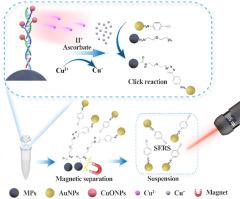Analytica Chimica Acta ( IF 5.7 ) Pub Date : 2022-06-07 , DOI: 10.1016/j.aca.2022.339958 Jieyu Hu 1 , Xingxing Yu 1 , Xiumei Zhuang 1 , Yan Sun 1 , Junjie Wang 1 , Haiting Ren 1 , Shenghao Zhang 1 , Yueshou Zhang 1 , Hongxing Qiu 1 , Yongjun Hu 1

|
The p53 gene is a known cancer marker. We report a novel protocol for the SERS tandem strategy to detect the p53 gene with high sensitivity. Herein, the click reaction between azide and alkyne was catalyzed by utilizing copper oxide nanoparticles (CuONPs), which were enriched by a T-DNA-triggered hybridization chain reaction (HCR). The T-DNA signal was amplified by establishing the correlation between the T-DNA signal and the concentration of CuONPs in a nonenzymatic isothermal environment. In contrast to other Raman reporters, we used alkynyl compounds as Raman reporters, which showed excellent characteristics in the Raman-silent region (1800–2800 cm−1). Therefore, the highly sensitive and highly selective SERS signals could be obtained in complex biological matrices. Due to utilizing multistep amplification strategies, including the nanoparticle-modified HCR polymer and “click” reaction, the limit of detection (LOD) and the limit of quantification (LOQ) of this sensor could be as low as 0.0174 pM and 0.0583 pM, respectively. The accuracy of the strategy expressed as the RSD was in the range of 3.14%–6.21%. The results indicated that the constructed sensor has excellent performance for the detection of the p53 gene in serum samples in a low concentration range, which suggests that the proposed enzyme-free SERS analytical sensor has good clinical application prospects.
中文翻译:

利用富含 DNA 聚合物的 CuO 纳米颗粒构建无酶生物传感器以催化点击化学反应用于 SERS 检测 p53 基因
p53 基因是一种已知的癌症标志物。我们报告了一种用于 SERS 串联策略的新方案,以高灵敏度检测 p53 基因。在此,叠氮化物和炔烃之间的点击反应是通过利用氧化铜纳米粒子 (CuONPs) 催化的,该纳米粒子通过 T-DNA 触发的杂交链式反应 (HCR) 进行富集。通过在非酶促等温环境中建立 T-DNA 信号与 CuONPs 浓度之间的相关性来放大 T-DNA 信号。与其他拉曼报告分子相比,我们使用炔基化合物作为拉曼报告分子,在拉曼静默区域(1800-2800 cm -1)。因此,可以在复杂的生物基质中获得高灵敏度和高选择性的 SERS 信号。由于采用多步放大策略,包括纳米粒子修饰的 HCR 聚合物和“点击”反应,该传感器的检测限 (LOD) 和定量限 (LOQ) 可分别低至 0.0174 pM 和 0.0583 pM . 以 RSD 表示的策略的准确度在 3.14%–6.21% 的范围内。结果表明,所构建的传感器在低浓度范围内对血清样本中p53基因的检测具有优异的性能,表明所提出的无酶SERS分析传感器具有良好的临床应用前景。











































 京公网安备 11010802027423号
京公网安备 11010802027423号